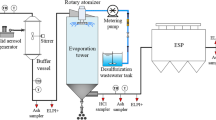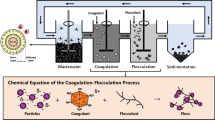Abstract
This research focused on developing a modified chemical precipitation (MCP) method for treating wet flue gas desulfurization (FGD) waste water by adding a solid powder reagent directly. Simulated wet FGD wastewater was treated by MCP method in simulation experiments. Optimization experiments were carried out with the help of response surface methodology (RSM) and central composite design (CCD) to evaluate the effects and the interactions of experimental variables, including reagent dosage, temperature and pH value. The optimal reagent dosage, temperature and pH value were 3018.0 mg/L, 40.5 °C and 5.7, respectively. The RSM was demonstrated as an appropriate approach for the optimization of wet FGD wastewater treatment with the MCP method. A comparative study between the MCP method and the traditional chemical precipitation (TCP) method on raw wet FGD wastewater treatment was conducted. Results indicate that the MCP had less reagent dosage and variety than the TCP method had. Thus, the MCP method had a lower cost.






Similar content being viewed by others
References
Srivastava RK, Jozewicz W (2001) Flue gas desulfurization: the state of the art. J Air Waste Manag Assoc 51(12):1676–1688
Gutiérrez Ortiz FJ (2010) A simple realistic modeling of full-scale wet limestone FGD units. Chem Eng J 165(2):426–439
Borgwardt RH (1980) Combined flue gas desulfurization and water treatment in coal-fired power plants. Environ Sci Technol 14(3):294–298
Lefers J, Van Den Broeke W, Venderbosch H et al (1987) Heavy metal removal from waste water from wet lime (stone): gypsum flue gas desulfurization plants. Water Res 21(11):1345–1354
Vendrup M, Sund C (1994) Treatment of wastewater from flue gas cleaning. Water Sci Technol 29(9):307–312
Andalib M, Arabi S, Dold P et al (2016) Mathematical modeling of biological selenium removal from flue gas desulfurization (FGD) wastewater treatment. Proc Water Environ Fed 11:228–248
Sonstegard J,Pickett T, Harwood J et al (2008) Full scale operation of GE ABMet® biological technology for the removal of selenium from FGD wastewaters. The international water conference. Orlando
Mooney FD, Murray-Gulde C (2008) Constructed treatment wetlands for flue gas desulfurization waters: full-scale design, construction issues, and performance. Environ Geosci 15(3):131–141
Sundberg-Jones SE, Hassan SM (2007) Macrophyte sorption and bioconcentration of elements in a pilot constructed wetland for flue gas desulfurization wastewater treatment. Water Air Soil Pollut 183(1–4):187–200
Shaw WA (2008) Benefits of evaporating FGD purge water. Power 152(3):59–63
Marlett JM (2012) Flue gas desulfurization (FGD) evaporator operation report, ENEL Brindisi. The international water conference. San Antonio
Nielsen P, Christensen T, Vendrup M (1997) Continuous removal of heavy metals from FGD wastewater in a fluidised bed without sludge generation. Water Sci Technol 36(2):391–397
Enoch G, van den Broeke W, Spiering W (1994) Removal of heavy metals and suspended solids from wastewater from wet lime (stone): gypson flue gas desulphurization plants by means of hydrophobic and hydrophilic crossflow microfiltration membranes. J Membr Sci 87(1):191–198
Enoch GD, Spiering W, Tigchelaar P et al (1990) Treatment of waste water from wet lime (stone): flue gas desulfurization plants with aid of crossflow microfiltration. Sep Sci Technol 25(13–15):1587–1605
Huang YH, Peddi PK, Tang C et al (2013) Hybrid zero-valent iron process for removing heavy metals and nitrate from flue-gas-desulfurization wastewater. Sep Purif Technol 118:690–698
Huang YH, Peddi PK, Zeng H et al (2013) Pilot-scale demonstration of the hybrid zero-valent iron process for treating flue-gas-desulfurization wastewater: part I[J]. Water Sci Technol 67(1):16–23
Huang YH, Peddi PK, Zeng H et al (2013) Pilot-scale demonstration of the hybrid zero-valent iron process for treating flue-gas-desulfurization wastewater: part II. Water Sci Technol 67(2):239–246
Seigworth A, Ludlum R, Reahl E (1995) Case study: integrating membrane processes with evaporation to achieve economical zero liquid discharge at the Doswell Combined Cycle Facility. Desalination 102(1):81–86
Bezerra MA, Santelli RE, Oliveira EP et al (2008) Response surface methodology (RSM) as a tool for optimization in analytical chemistry. Talanta 76(5):965–977
Del Castillo E, Montgomery DC, McCarville DR (1996) Modified desirability functions for multiple response optimization. J Qual Technol 28:337–345
Kang Y, Lu J, Guo J (2015) Experimental study on effects of FGD wastewater treatment by “one-step” process. Thermal Power Gener 44(6):58–62
Sakhare N, Lunge S, Rayalu S et al (2012) Defluoridation of water using calcium aluminate material. Chem Eng J 203:406–414
Kumar E, Bhatnagar A, Hogland W et al (2014) Interaction of anionic pollutants with Al-based adsorbents in aqueous media: a review. Chem Eng J 241:443–456
Freundlich H (1906) Adsorption in solution. Z Phys Chem 57:384–470 (in German)
Author information
Authors and Affiliations
Corresponding author
Electronic supplementary material
Below is the link to the electronic supplementary material.
Rights and permissions
About this article
Cite this article
Kang, Y., Lu, J. & Guo, J. Treatment of Wet FGD Wastewater by a Modified Chemical Precipitation Method Using a Solid Powder Reagent. Trans. Tianjin Univ. 23, 110–121 (2017). https://doi.org/10.1007/s12209-017-0027-4
Received:
Revised:
Accepted:
Published:
Issue Date:
DOI: https://doi.org/10.1007/s12209-017-0027-4




